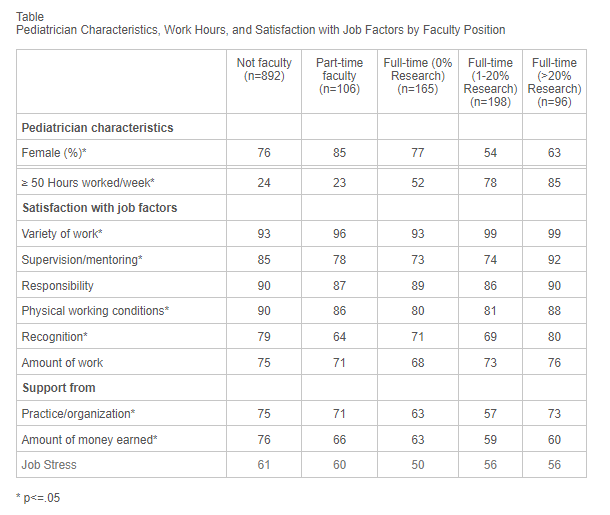William L. Cull, PhD,1 Mary Pat Frintner, MSPH,1 Amy J. Starmer, MD, MPH2
1American Academy of Pediatrics, Research, Itasca, IL; 2Boston Children’s Hospital / Harvard Medical School, Boston, MA Presented at the 2018 Pediatric Academic Societies Annual Meeting
Background: While academic faculty careers are common among pediatricians, less is known about the characteristics and work experiences of pediatricians in these positions.
Objective: Estimate the percentage of U.S. early to midcareer pediatricians working in academic faculty positions and describe the experiences of those pediatricians.
Design/methods: 2017 data from the AAP Pediatrician Life and Career Experience Study (PLACES) were used to examine national samples of pediatricians graduating residency in 2002-2004 and 2009-2011. Of the 1804 PLACES participants, 1457 (81%) responded in 2017 to the items used in these analyses. Pediatricians were categorized based on their report of having an academic faculty position and on the percent of time they spend in research: nonfaculty, part-time faculty, full-time faculty (0% research), fulltime faculty (1-20% research), and full-time faculty (>20% research). Pediatricians with adjunct, volunteer, or courtesy faculty positions were included in the non-faculty group. Chi-square tests were used to compare faculty groups based on their a) characteristics, b) hours worked and c) satisfaction with various aspects of their jobs. Satisfaction was dichotomized as somewhat or completely satisfied versus completely or somewhat dissatisfied. Multivariable regression was used to test whether each of the bivariate associations remained when controlling for pediatrician characteristics.
Results: Of respondents, 39% reported they are currently in an academic faculty position; 7% part-time, 11% full-time with 0% research, 14% full-time with 1-20% research, and 7% full-time with >20% research. Those in the full-time >20% research and 1-20% research positions worked the longest hours (Table). Overall, those without faculty positions and those in full-time >20% research positions were the most satisfied across items. Those in part-time faculty, full-time 0% research, and full-time 1-20% research positions were less likely to report being satisfied with their recognition, supervision/mentoring, and support from their practice/organization. Non-faculty were the most satisfied with their pay. All the bivariate relationships, except cohort, remained significant in the multivariable models.
Conclusion(s): 4 in 10 early and midcareer pediatricians have academic faculty positions, with many faculty members focused exclusively on clinical care or teaching. The majority of pediatricians from all groups reported satisfaction with various aspects of their jobs, but less satisfaction was apparent in some areas among non-research-focused faculty.
